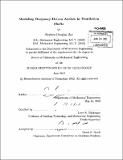Modeling buoyancy-driven airflow in ventilation shafts
Author(s)
Ray, Stephen D. (Stephen Douglas)
DownloadFull printable version (28.42Mb)
Other Contributors
Massachusetts Institute of Technology. Dept. of Mechanical Engineering.
Advisor
Leon R. Glicksman.
Terms of use
Metadata
Show full item recordAbstract
Naturally ventilated buildings can significantly reduce the required energy for cooling and ventilating buildings by drawing in outdoor air using non-mechanical forces. Buoyancy-driven systems are common in naturally ventilated commercial buildings because of their reliable performance in multi-story buildings. Such systems rely on atria or ventilation shafts to provide a pathway for air to rise through the building. Although numerous modeling techniques are used to simulate naturally ventilated buildings, airflow network tools (AFNs) are most commonly used for annual simulations. These AFNs, however, assume minimal momentum within each zone, which is a reasonable approximation in large atria, but is inappropriate in smaller ventilation shafts. This thesis improves AFNs by accounting for momentum effects within ventilation shafts. These improvements are validated by Computation Fluid Dynamics (CFD) models that haven been validated by small scale and full scale experiments. The full scale experiment provides a detailed data set of an actual atrium that can be used in further validations and demonstrates the first use of a neutrally buoyant bubble generator for flow visualization and particle image velocimetry within a buoyancy driven naturally ventilated space. Small scale experiments and CFD simulations indicate an "ejector effect" within the shaft that uses momentum from lower floors to induce flow through upper floors. In some configurations, upper floors achieve higher flow rates than lower floors. Existing AFNs do not predict this "ejector effect" and are shown to significantly under predict flow rates through ventilation shafts by 30-40%. Momentum effects are accounted for in AFNs using empirical relationships for discharge coefficients. This approach maintains the current structure of AFNs while enhancing their ability to simulate airflow through ventilation shafts. These improvements are shown to account for the "ejector effect" and predict airflow rates that agree with CFD simulations to within 1-25%.
Description
Thesis (Ph. D.)--Massachusetts Institute of Technology, Dept. of Mechanical Engineering, 2012. Cataloged from PDF version of thesis. Includes bibliographical references (p. 185-191).
Date issued
2012Department
Massachusetts Institute of Technology. Department of Mechanical EngineeringPublisher
Massachusetts Institute of Technology
Keywords
Mechanical Engineering.